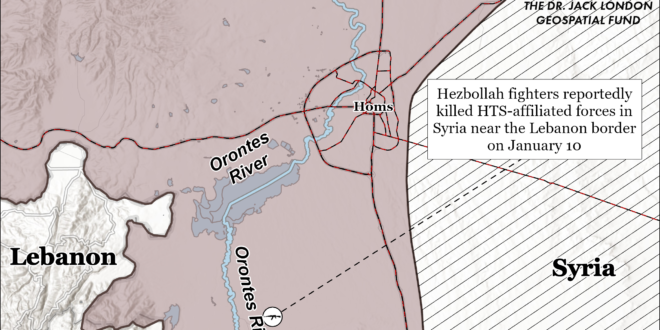Israeli and Hamas officials appear to be optimistic after achieving a “breakthrough” in ceasefire negotiations in Doha on January 13. Israel and Hamas have yet to solve at least two outstanding issues, however.[1] Two Israeli officials told Axios that mediators from Qatar, the US, and Egypt presented Hamas with a “final draft” of the agreement.[2] The draft stipulates that Hamas must release 33 hostages during a 42-day ceasefire in the Gaza Strip. Israel will begin negotiations on the 16th day of the ceasefire to secure the release of the remaining hostages in exchange for “high-profile” Hamas members, according to details shared by an Israeli military correspondent.[3]
Negotiations over the buffer zone and a continued IDF presence in the Gaza Strip remain sticking points.[4] Israeli officials told an Israeli military correspondent that the IDF will maintain its presence in the Netzarim and Philadelphi corridors, which are two operationally significant IDF-held areas, between the first and second phase of the ceasefire agreement.[5] Another presumably separate Israeli official told Axios that the IDF will “gradually withdraw” to a buffer zone along the border and that the IDF will withdraw from the corridors.[6] The official did not make clear when the IDF would withdraw from the corridors. A Hamas official told CNN that negotiations regarding the buffer zone and a permanent ceasefire are ongoing and remain “sticking points.”[7] Hamas demands the buffer zone return to its pre-war width of 300-500 meters, while Israel insists on a two-kilometer-wide zone along Gaza’s eastern and northern boundaries.[8] The IDF intends to use this buffer zone to protect Israeli communities in southern Israel. Israel will not completely withdraw from the Gaza Strip until its war objectives are achieved, among them the return of all the hostages, according to Israeli officials speaking to an Israeli military correspondent.[9]
Hamas is attempting to rebuild its military organization, but persistent IDF pressure and the severely degraded state of Hamas’ military forces will make this process extremely difficult and long. The Wall Street Journal reported that senior Hamas military commander in the Gaza Strip Mohammad Sinwar has reportedly begun operating autonomously from the main Hamas leadership and ignored the Hamas decision to make decisions through a leadership council.[10] Sinwar has begun recruiting Gazans by targeting funerals and prayer gatherings and offering food, aid, and medical assistance in return for service.[11] Hamas has obtained some of these resources by hijacking aid convoys. The Wall Street Journal also reported that Hamas is using unexploded ordinance to build new improvised explosive devices.[12] New recruits are not capable of successfully disassembling and reassembling unexploded ordinance to build improvised explosive devices. Such efforts require relatively experienced explosives experts. The loss of those experts due to Israeli military action would likely have outsized effects on the nascent reconstructed Hamas military organization, which will already need substantial time and space to reconstitute itself.
Current Israeli military operations are designed to prevent the successful regeneration of Hamas by denying Hamas adequate safe areas to train new recruits, particularly in the northern Gaza Strip. The IDF has successfully achieved two key operational-level objectives: the isolation of Hamas military forces in the northern Strip and the destruction of Hamas’ military organization. Hamas fighters are now operating as small fighting cells and not organized military units that Hamas had in the early days of the war. Military units have institutionalized command, recruitment, and replenishment functions that make them resilient in the face of casualties and degradation. Individual cells of fighters lack this institutionalization and are relatively easy to destroy. A decentralized, guerrilla force like the one Hamas employs can “wait out” the Israelis and prepare to rebuild, however. The IDF is preventing the reconstitution of Hamas units by isolating Hamas’ forces in the north and denying them sanctuary there by repeatedly raiding areas where Hamas is strong.[13] These raids gradually attrit Hamas fighters and make it impossible for Hamas to train their new recruits to make them competent and capable against the IDF.[14]
Sinwar has likely delegated control of day-to-day efforts in the northern Gaza Strip to Hamas Gaza City Brigade commander Izz al Din al Haddad, as CTP-ISW has previously assessed.[15] The successful IDF effort to isolate the northern Gaza Strip both above and below ground means that it is highly unlikely that Sinwar is capable of communicating with forces in the north by runner or other physical means. Sinwar or someone close to him could presumably communicate electronically, but the use of electronic communications would be extremely risky and therefore unlikely to enable Sinwar to exert day-to-day control over Hamas’ military organization in the northern Strip. Sinwar likely retains significant control over Hamas forces in the central Gaza Strip and in Khan Younis, however.[16] The IDF raids these areas only rarely and it is not permanently present close to many of the major Gazan towns and cities in the Central Camps or Khan Younis areas.
The IDF’s operational success in the Gaza Strip obscures the strategic insufficiency of IDF operations if the Israeli government desires to destroy Hamas fully. Sinwar and his close commanders will almost certainly begin to rebuild Hamas after any IDF withdrawal, though such an effort will take years of patient reconstitution.[17] It is also far from clear that Sinwar would decide to rebuild Hamas in the same way Hamas built itself from the 1990s to 2023, given the obvious failure of Hamas’ military operations in the Gaza Strip and the inability of those operations to achieve any of Hamas’ war aims. These war aims include the destruction of the Israeli state by triggering a regional war or the destruction of the Abraham Accords.
Turkey and the Turkish-backed Syrian National Army (SNA) may be attempting to stretch the Syrian Democratic Forces (SDF)’s bandwidth by threatening multiple areas simultaneously. Turkey and the SNA continued shelling SDF positions along both the line of control and deeper into SDF-held territory on January 13.[18] The SNA has also reportedly deployed forces to the line of control near Tal Tamr since at least January 8.[19] These deployments and the shelling around Tal Tamr will almost certainly force the SDF to deploy forces to the area to protect against any possible Turkish-SNA offensive, thus fixing significant SDF forces far from the main fighting near the Euphrates. Turkey and the SNA can therefore force the SDF to stretch its bandwidth by allocating forces to Tal Tamr without an attack from Tal Tamr. Stretching the SDF’s bandwidth would likely make Turkish or SNA operations near Kobani or the Euphrates River much easier.
Turkey has continued to support SNA efforts to isolate and destroy SDF elements along the Euphrates River. Turkey and the SNA are attempting to isolate the SDF forces in their bridgeheads on the western bank of the Euphrates by striking along supply lines and key nodes behind the front while pressuring the SDF bridgeheads with ground attacks. Local, anti-SDF media reported that Turkey struck an SDF barracks and two guard posts in Sarrin, east of the Qara Qozak bridge.[20] The SDF operates from a base in Sarrin that Russian forces evacuated after the fall of the regime, meaning that Turkey is striking an SDF rear base that could be used to sustain the bridgeheads.[21] Turkey also reportedly conducted several airstrikes targeting SDF positions west of the Tishreen Dam.[22]
The SNA has followed up these airstrikes by pressuring the SDF bridgehead on the western bank of the Euphrates. Geolocated footage posted on January 13 showed SNA-affiliated fighters firing small arms at an unseen target in a village northwest of Tishreen Dam.[23] The SDF posted footage on January 12 of an SDF drone strike that targeted an SNA personnel carrier.[24] Neither the SDF nor SNA appears to have made any significant territorial gains as of this writing, but the pressure that the SNA has put these bridgeheads under will make it difficult for the SDF to disengage and withdraw in good order if the SNA or Turkey forces the SDF to contend with a threat to its rear. Withdrawing a military force while under enemy pressure is an extremely difficult undertaking, particularly when the withdrawing force comes under pressure from a large military force.[25] The enemy force—if it discovers a withdrawal is underway—will typically attempt to turn the withdrawal into a rout to destroy the withdrawing force.[26]
Geolocated footage posted by the commander of the Suleiman Shah Brigades—a faction affiliated with the SNA—on January 13 showed SNA armored vehicles traveling through a village northwest of Tishreen Dam.[27] Abu Amsha claimed that the video showed SNA reinforcements arriving at the frontlines.[28] The SNA may seek to move more forces to the frontline in order to continue pressuring the SDF positions or prepare for a large-scale assault to collapse the bridgehead.
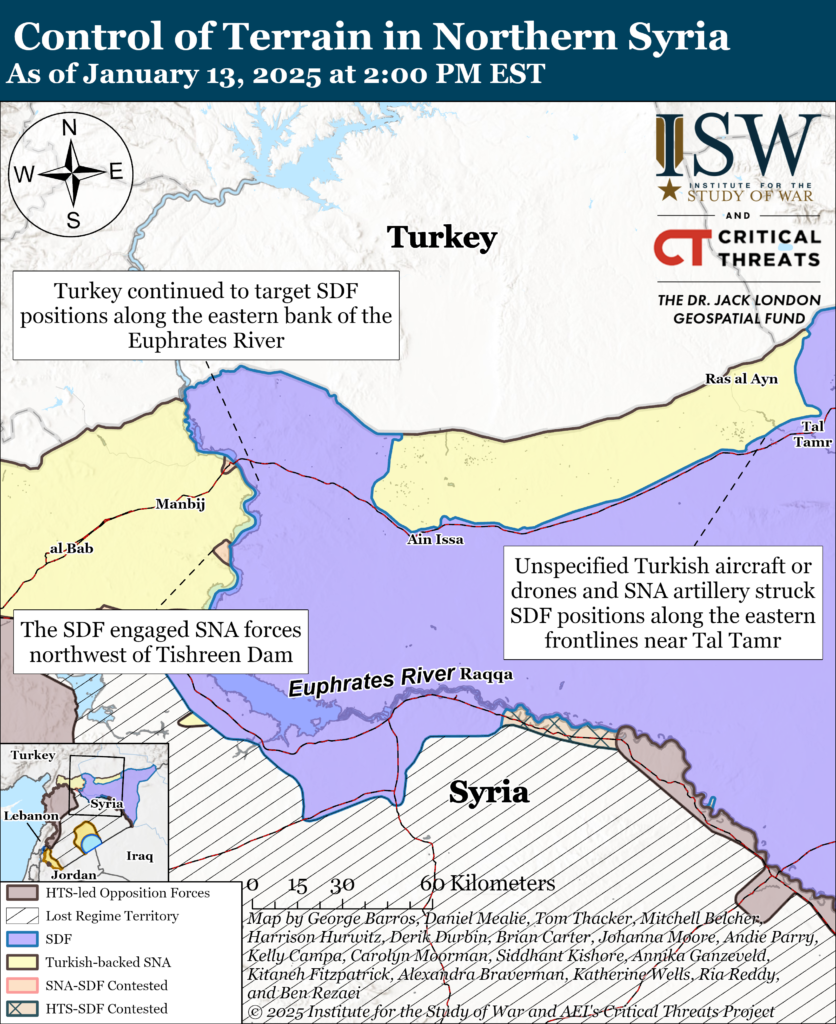
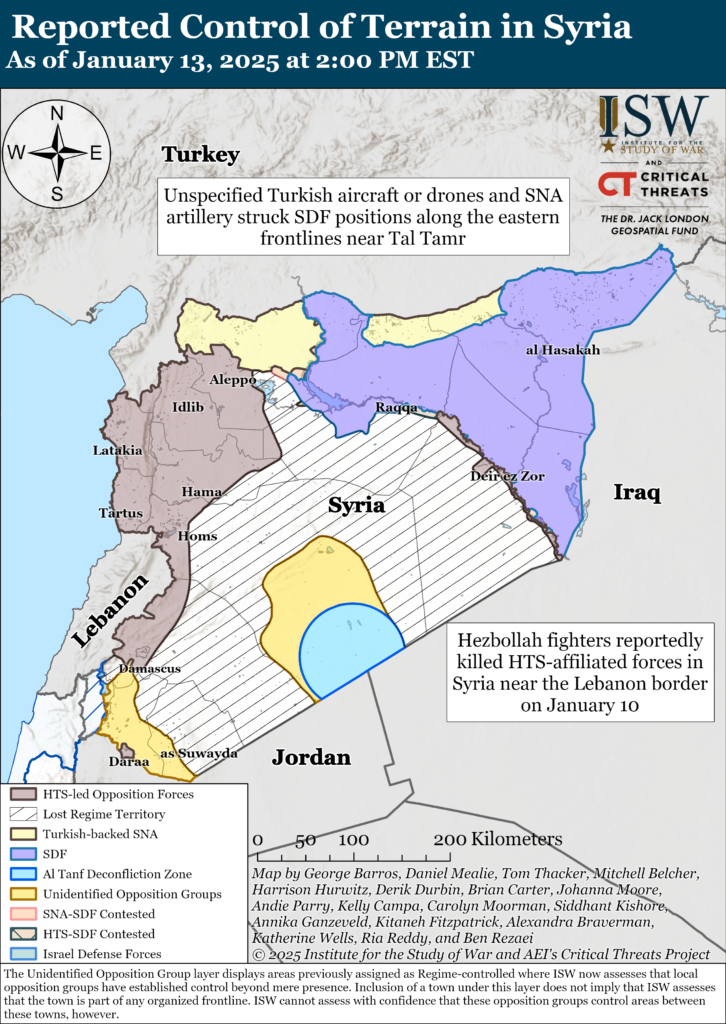
Key Takeaways:
Gaza Strip Ceasefire: Israeli and Hamas officials appear to be optimistic after achieving a “breakthrough” in ceasefire negotiations in Doha on January 13. Negotiations over the buffer zone and a continued IDF presence in the Gaza Strip remain sticking points.
Hamas Reconstitution: Hamas is attempting to rebuild its military organization, but persistent IDF pressure and the severely degraded state of Hamas’ military forces will make this process extremely difficult and long. Current Israeli military operations are designed to prevent the successful regeneration of Hamas by denying Hamas adequate safe areas to train new recruits, particularly in the northern Gaza Strip.
Hamas Leadership: The Wall Street Journal reported that senior Hamas military commander in the Gaza Strip Mohammad Sinwar has reportedly begun operating autonomously from the main Hamas leadership and ignored the Hamas decision to make decisions through a leadership council. Sinwar has likely delegated control of day-to-day efforts in the northern Gaza Strip to Hamas Gaza City Brigade commander Izz al Din al Haddad.
Turkish and Syrian National Army (SNA) Operations: Turkey and the SNA may be attempting to stretch the Syrian Democratic Forces (SDF)’s bandwidth by threatening multiple areas simultaneously. Turkey has continued to support SNA efforts to isolate and destroy SDF elements along the Euphrates River.
SDF Bridgeheads on the Euphrates: Neither the SDF nor SNA appears to have made any significant territorial gains around the bridgeheads, but the pressure that the SNA has put these bridgeheads under will make it difficult for the SDF to disengage and withdraw in good order if the SNA or Turkey forces the SDF to contend with a threat to their rear. Withdrawing a military force while under enemy pressure is an extremely difficult undertaking, particularly when the withdrawing force comes under pressure from a large military force.
Syria
Axis of Resistance objectives:
Reestablish ground lines of communication through Syria to Lebanon
Reestablish Iranian influence in Syria
Syrian media reported that Free Syrian Army officers will receive “special status” in the Syrian army suggests that HTS will continue to favor loyalists and consolidate HTS control over Syria’s military and defense apparatus. Syrian outlet Al Watan, citing unspecified sources, reported on January 13 that Syrian Defense Ministry officials have agreed upon a structure for the new volunteer-based Syrian defense apparatus with “most” armed factions, including the SNA.[29] Al Watan reported that officers from the Free Syrian Army (FSA) will be given “special status” in the Defense Ministry.[30] The Free Syrian Army is an umbrella of Syrian opposition groups that formed in 2011, and many of the factions affiliated or formerly affiliated with the FSA are subordinated to HTS as part of the Fateh Mubin operations room that overthrew the Assad regime.[31] CTP-ISW cannot verify Al Watan’s reporting, but that FSA officers would receive “special status” in the armed services is consistent with HTS leader Ahmed al Shara and the Syrian Defense Ministry’s treatment of factions aligned with HTS. The Syrian Defense Ministry recently promoted 42 individuals within the Syrian armed forces, many of whom were from FSA-affiliated factions, including Jaysh al Izza, Harakat Nour al Din al Zenki, and the Free Idlib Army.[32] HTS, not the FSA, has actual control over many of these groups, however, including Jaysh al Izza and Harakat Nour al Din al Zenki. [33] Syrian Interim Defense Minister Marhaf Abu Qasra has also met with numerous leaders and representatives from these factions in recent weeks.[34] The promotion of loyalists and possible ”special status” given to FSA leaders would allow HTS to consolidate functional control over the core of the Syrian military.
The HTS-led Military Operations Department deployed to southern Syria to seize weapons on January 13. Interim government media reported that government forces deployed to several towns in Quneitra Province to maintain security and seize weapons.[35] A commander in the interim security forces announced his forces had launched an operation in Ghabagheb, northern Daraa Province, to search for stolen weapons and drug traffickers.[36]
Hezbollah fighters reportedly killed HTS-affiliated forces in Syria near the Lebanon border on January 10. A Syrian source claimed that Hezbollah fighters killed five HTS fighters in western Qusayr and subsequently wrote threatening messages on their bodies.[37] Other Syrian sources said that the Hezbollah fighters killed five civilians, however.[38] CTP-ISW cannot independently verify the parties involved in the engagement or that it occurred. This engagement would be notable however, given that Qusayr lies on a key line of communication that Hezbollah has long used to move weapons and other equipment into Lebanon.[39] The Qusayr area has long served as a smuggling route for other armed groups, including some hostile to Hezbollah and Iran. HTS-led Syrian interim government officials met with a senior Lebanese delegation in Damascus to discuss border security, counter-smuggling efforts, and immigration on January 11, a day after the reported engagement.[40] These border smuggling routes, including near Qusayr, could allow Lebanese Hezbollah to reconstitute militarily. The border policies that the HTS-led interim government and Lebanon enact in the coming months will be one of many factors in determining how easily Iran can revive its ground line of communication to Hezbollah.
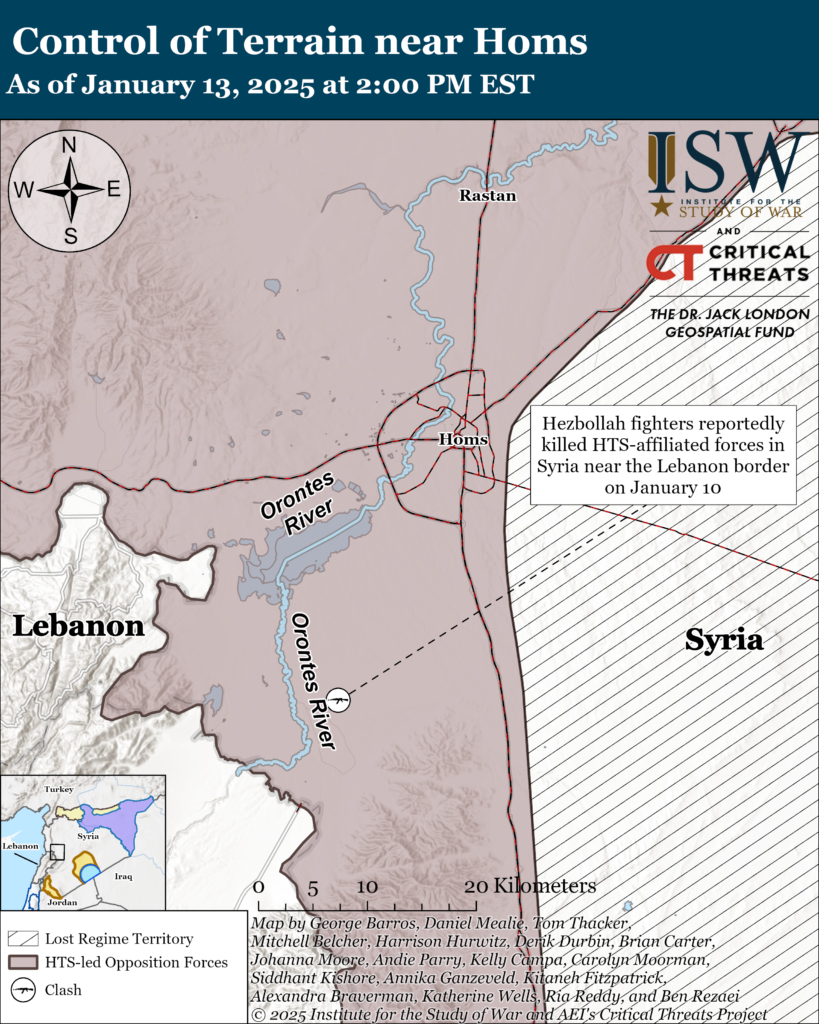
The Syrian Oil Ministry will begin to search for and extract oil and gas within the next month.[41] Assad loyalists and groups such as the Iranian IRGC Quds Force-linked and US Treasury-sanctioned al Qaterji Company previously controlled petrochemical extraction in Syria.[42] The interim Syrian government may be able to raise funds for its administration and alleviate energy deficits in Syria through this oil exploration.[43] Iran previously supplied 90 percent of Syria’s crude oil before the fall of Assad.[44]
Six European Union (EU) member states called for the EU to temporarily lift sanctions on various sectors in Syria on January 13, according to a paper seen by Reuters.[45] Germany, France, the Netherlands, Spain, Finland, and Denmark signed a document that called for the EU to ”immediately begin adjusting our sanctions regime” on Syria to facilitate civilian flights, the trade of high-value goods, oil and gas technology, and to reopen financial channels between Syria and the EU. The document added that the EU should not lift other sanctions on Syria. It also said that the EU could apply a snapback mechanism for sanctions that have already been removed if the interim Syrian government does not uphold EU expectations on human rights and minorities. The signatories clarified that the EU should retain sanctions against former Assad regime members. The EU’s High Representative for Foreign Affairs and Security Policy Kaja Kallas met with Syria’s interim Foreign Minister Assad Hassan al Sheibani in Riyadh on January 12. The EU Foreign Ministers will meet in Brussels on January 27 to discuss relaxing sanctions on Syria.
An Iranian media outlet that is affiliated with a former IRGC commander continues to publish unverified inflammatory information about HTS activity around the Sayyidah Zeinab shrine that appears designed to enflame sectarian tension. The first Iraqi Shiite pilgrims arrived at the shrine peacefully on January 12.[46] Tabnak, which is affiliated with former IRGC Commander Mohsen Rezaei also reported on January 12 that one of the HTS-led coalition leaders announced that in order to visit the Sayyidah Zeinab shrine in Damascus pilgrims would need to pay 10,000 USD.[47] CTP-ISW cannot confirm the veracity of this information or why precisely Tabnak has repeatedly recirculated sectarian narratives. The HTS-led government took responsibility for securing the shrine on December 15.[48] Tabnak has previously published footage of HTS-led coalition members allegedly disrespecting the shrine.[49]
Iraq
Axis of Resistance objectives:
Strengthen Iranian and Axis of Resistance influence over the Iraqi state and society
Harden the Iraqi government against internal dissent
An IRGC-affiliated media outlet said that a group of Iraqis, whom the outlet characterized as Shias cooperating with the Axis of Resistance, aim to restructure the Popular Mobilization Forces (PMF) into a “coordination” structure from a command structure.[50] Iraqi political groups ”opposed to the resistance” alternatively proposed that a ”significant number” of groups within the PMF should dissolve but that the PMF should retain its current structure.[51] The PMF is an Iraqi state security service that includes a large number of Iranian-backed Iraqi militias. The PMF reports directly to Sudani on paper, but many of the militias that comprise the PMF answer to Iran in reality. This report comes as the Iraqi federal government is considering integrating Iranian-backed Iraqi militias into the Iraqi armed forces, which would facilitate the Iranian capture of the Iraqi security sector.[52]
The 30th Popular Mobilization Forces (PMF) Brigade (Badr Organization) deployed to Ninewa Province on January 13.[53] The forces conducted searches for “terrorist presence“ and to prevent border infiltration from Syria into Iraq.[54] The PMF and the Badr Organization frequently deploy PMF units to Ninewa Province to search for ISIS cells. This deployment is notable nonetheless, given the recent increased Iraqi Army and PMF forces on the Iraq-Syria border and Badr Organization head Hadi al Ameri’s inspection of border units due to security concerns following the fall of the Bashar al Assad regime.[55] The 30th Brigade is a Badr Organization unit that operates in Ninewa Province in northern Iraq and has strong ties to other members of the Islamic Resistance of Iraq—a coalition of Iranian-backed Iraqi militias—including Kataib Hezbollah and Harakat Hezbollah al Nujaba.[56]
Arabian Peninsula
Axis of Resistance objectives:
Harden the Houthi regime against internal dissent in Houthi-controlled areas
Destroy the anti-Houthi opposition in order to control all of Yemen
Erode Israeli will to continue the war in the Gaza Strip
The Houthis conducted a ballistic missile attack and separately launched four drones targeting the Tel Aviv-Jaffa area on January 13.[57] IDF Air Force intercepted a drone and a missile from Yemen before they entered Israeli territory.[58]
Greece and a British maritime security company said on January 13 that six companies successfully unloaded 150,000 tons of crude oil from an oil tanker after a Houthi attack targeting the vessel in August 2024.[59] The Houthis launched several drones and missiles targeting the 900-foot Greek-registered oil tanker Sounion 58 miles off the coast of Yemen in August 2024.[60] The European Union’s naval force in the Red Sea, Operation Aspides, towed the tanker to a safe location near Saudi Arabia and spent three weeks extinguishing fires on the vessel before offloading the cargo.[61] Reuters reported that more than 200 people and six companies were involved in the operation.
The Palestinian Territories and Lebanon
Axis of Resistance objectives:
Erode the will of the Israeli political establishment and public to sustain clearing operations in the Gaza Strip
Reestablish Hamas as the governing authority in the Gaza Strip
Rebuild and reestablish Hezbollah in southern Lebanon
Establish the West Bank as a viable front against Israel
The Gaza Strip
An Israeli Army Radio correspondent reported on January 13 that the IDF will soon replace the 143rd Division with the 162nd Division in the northern Gaza Strip.[62] The IDF has been rotating division-level headquarters into the Gaza Strip at regular intervals
Palestinian militias likely detonated an improvised explosive device (IED) that collapsed a building in Beit Hanoun, northern Gaza Strip, on January 13, killing five Israeli soldiers from the 933rd Infantry Brigade (162nd Division).[63] The collapse of the building also injured eight other Israeli soldiers, according to the IDF.[64] An Israeli Army Radio correspondent reported that Palestinian militias have killed 15 Israeli soldiers in Beit Hanoun in the last week.[65]
Palestinian militias claimed four mortar and rocket attacks targeting the IDF along the Netzarim Corridor since CTP-ISW’s last data cut off on January 12.[66]
Hamas claimed that it targeted Israeli soldiers in a building with “various types of weapons” in Rafah City, southern Gaza Strip, on January 13.[67] Hamas fighters then detonated an IED targeting two armored personnel carriers that arrived to rescue the Israeli soldiers. The IDF has not commented on these claims as of this writing.
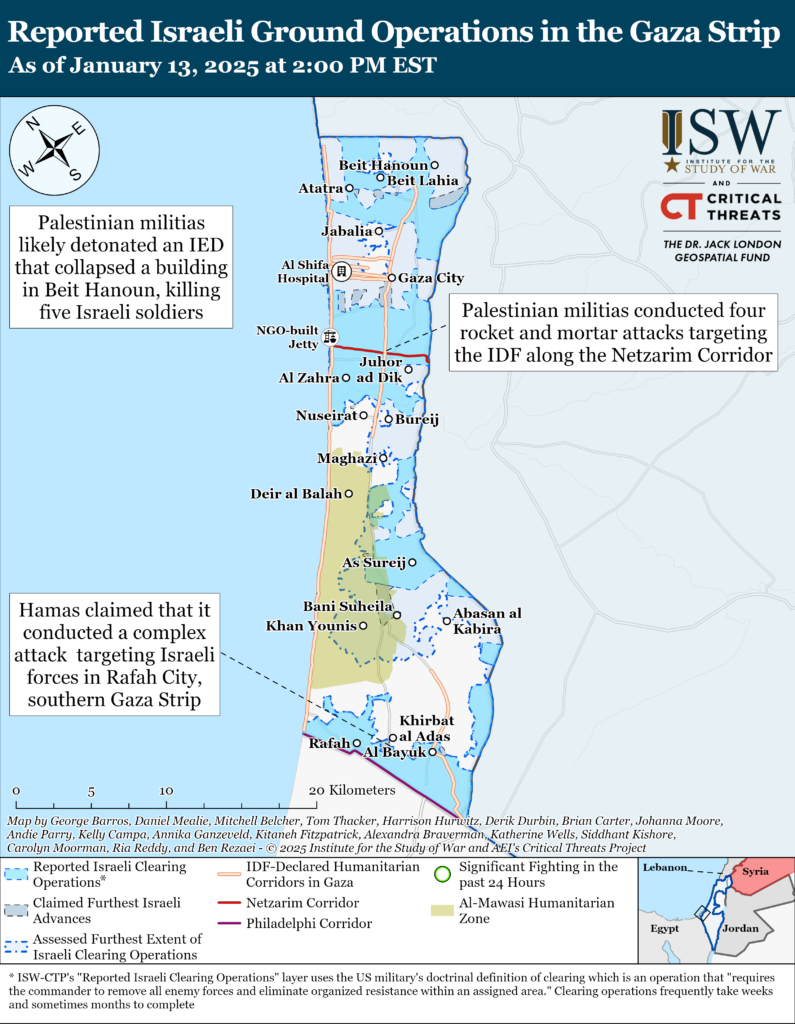
Lebanon
The IDF Air Force conducted airstrikes on January 12 targeting Hezbollah military sites across Lebanon and a Lebanon-Syria border crossing used to transfer weapons and move fighters.[68] The IDF stated that it notified the Israel-Lebanon ceasefire monitoring committee about the threats, but that that committee failed to act.[69] The IDF said that its targets included a Hezbollah rocket launcher, a military site, and Syria-Lebanon border crossing previously used by Hezbollah to transfer weapons.[70] Israeli media reported that the IDF struck the Lebanon-Syria border crossing in Janta, northern Lebanon, which Hezbollah has used to move weapons and fighters.[71] Israeli and Lebanese media reported an IDF airstrike targeting Houmin el Faouqa, north of the Litani River.[72] Lebanese media reported additional strikes in Arab Salim, Deir El Zahrani, Roumine, Matraba, and the Lebanon-Syria border crossing in Hermel.[73]
The Lebanese Parliament elected the current International Court of Justice Head Nawaf Salam as prime minister on January 13.[74] Hezbollah’s preferred candidate, current interim Prime Minister Najib Mikati, congratulated Salam on his appointment after Mikati received only nine out of 128 votes to remain prime minister.[75] Many Lebanese legislators have described Salam’s appointment as a ”new era” for Lebanese politics.[76] Newly-elected Lebanese President Joseph Aoun asked Salam to form a government on January 13.[77]
Lebanese and Hezbollah-affiliated media claimed on January 13 that Israeli forces conducted “large-scale” ground operations in Khiam, Marjaayoun Province.[78] Israeli forces previously withdrew from Khiam on December 11.[79] CTP-ISW cannot independently verify IDF’s presence in Khiam or the scale of operations there at this time.
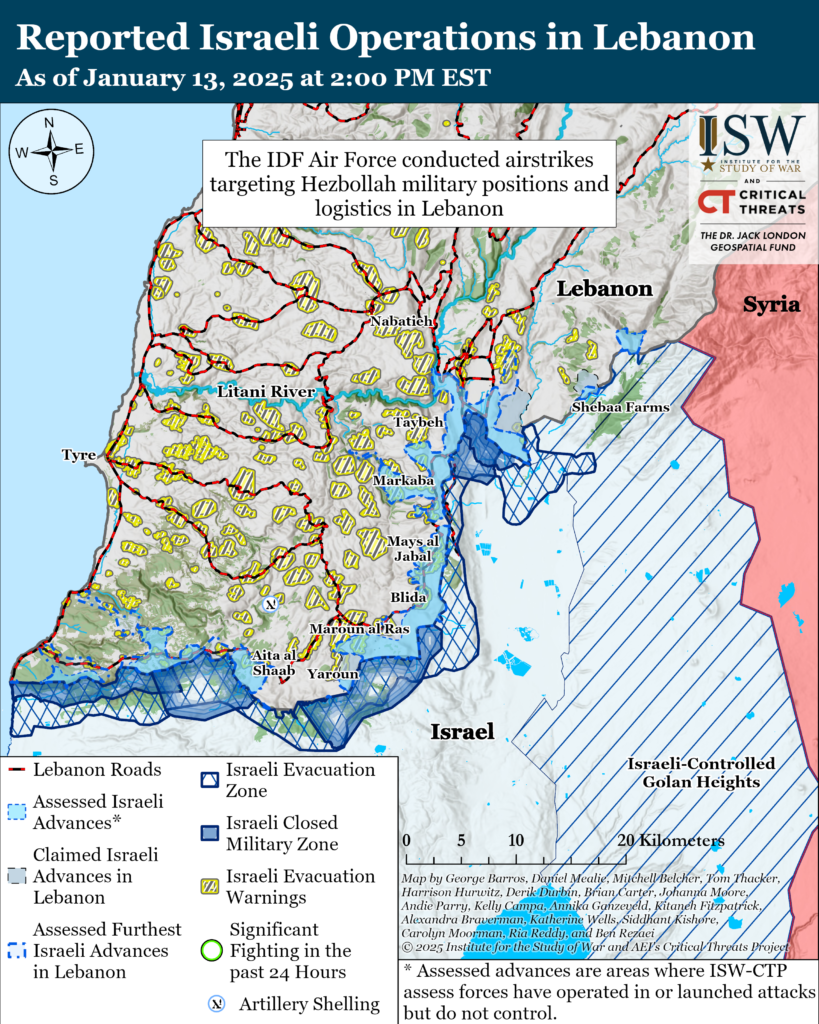
West Bank
Iranian Decision-Making, Internal Dynamics, and Foreign Policy
UK outlet the Times reported on January 12 that Senior Adviser to the Iranian Supreme Leader Ali Larijani has been covertly flying between Iran and Russia to meet with unspecified senior Russian officials.[80] The Times added that Larijani‘s trips are part of Iran’s effort to gain Russian assistance on Iran’s nuclear program and air defense capabilities. Israeli airstrikes on October 25 destroyed much of Iran’s advanced air defense capabilities.[81] These meetings reportedly occurred just before the Kremlin and Tehran both confirmed Iranian President Masoud Pezeshkian‘s January 17 visit to Moscow to sign the new Russo-Iranian comprehensive strategic agreement, which will cover areas of defense and energy trade.[82] The talks will also cover Iran’s nuclear program. An Iranian delegation is separately meeting with E3 countries — the United Kingdom, France, and Germany — in Geneva on January 13 and 14 for the second round of nuclear talks.”[83] The German foreign ministry told AFP that these talks were ”consultations” and ”not negotiations.”
Iranian Defense and Armed Forces Logistics Minister Brigadier General Aziz Nasir Zadeh claimed on January 13 that the Iranian defense industry and military have acquired 1,000 unspecified Iranian-made drones over an unspecified period of time.[84] Some of these drones reportedly have over 2,000 km range, according to Iranian media. Islamic Revolutionary Guards Corps (IRGC) Ground Forces Commander Brigadier General Mohammad Pakpour separately claimed on January 13 that the IRGC Ground Forces had acquired an unspecified number of drones with ranges of 40 km to 100 km.[85] IRGC-affiliated media added that the IRGC is in a better position to ”more effectively” combat terrorist attacks with this new drone technology, especially in Iran’s “mountainous geography.” IRGC Ardabil Abbasid Corps Commander General Gholam Hossein Mohammadi Asl also announced on January 13 that the Basij and IRGC forces will conduct a large-scale combined military exercise in Ardabil province.[86] This follows several recent IRGC and Artesh air defense and ground drills in western Iran, which are part of the Iranian military’s annual series of military exercises.[87]
 Eurasia Press & News
Eurasia Press & News
